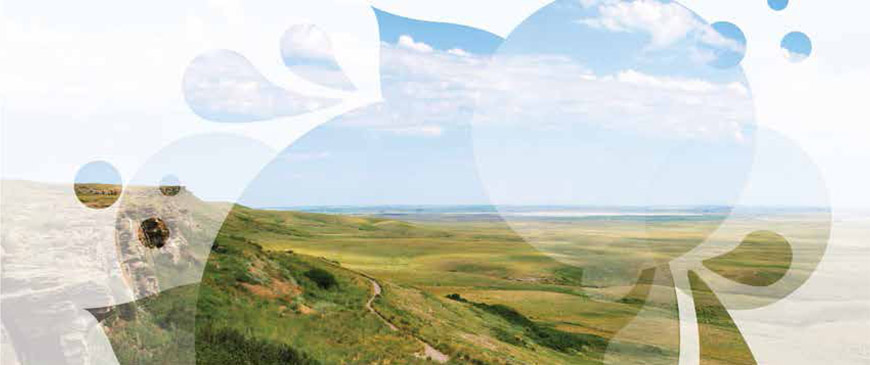
ABMI releases new report on the status of biodiversity in the Prairie Region of Alberta
Latest numbers show 37% of the Prairie Region of Alberta remains as native vegetation. Biggest ecological change: species that require native prairie habitat have lower-than-expected abundance.
EDMONTON, February 17, 2016 - As of 2013, 37% of the Prairie Region[1] of Alberta remained as native vegetation according to the latest report by the Alberta Biodiversity Monitoring Institute (ABMI). In other words, the majority of the land base in the Prairie Region has been visibly transformed by human development.
The report, “The Status of Biodiversity in the Grassland and Parkland Regions of Alberta”, presents the latest data on several indicators of environmental health—species, habitat, and human footprint—for the Prairie Region of the province. The region is one of few in North America that contain large tracts of temperate native grassland, an ecosystem type among the most threatened in the world.
The Prairie Conservation Forum (PCF), a non-profit organization with a mandate to promote the conservation of native biodiversity in prairie and parkland environments in Alberta, commissioned the report to provide an inventory and assessment of regional biodiversity for the new 2016-2020 Prairie Conservation Action Plan. The report also highlights results for a sub-region within the Prairie Region identified as the High Value Landscape, an area defined by native vegetation, species at risk and more.
With respect to the Prairie Region, human footprint covered 63.1% as of 2013. By contrast, inside the High Value Landscape, human footprint was less than half, at 30.8%. Agriculture was the dominant footprint type, measuring at 55.2% for the Prairie Region, with transportation and energy trailing far behind at less than 3%. Of note, however, between 1999-2013, the High Value Landscape showed a larger increase in the per cent area of human footprint.
Based on an assessment of 197 species, the corresponding Biodiversity Intactness Index[2] is, on average, 53% for the Prairie Region and 69% for the High Value Landscape. The biggest ecological changes are associated with the lower-than-expected abundance of species that require native prairie habitat, such as the Baird’s Sparrow, Sprague’s Pipit, and many vascular plant species. In the case of species that thrive in agricultural landscapes or disturbed habitat, such as Coyote, Chipping Sparrow, and Foxtail Barley, they were found to be more abundant than expected.
The report also examines the number and abundance of non-native plants, since, given the right conditions, non-native species can become a major ecological concern. In the Prairie Region, an average of nine non-native plant species were detected at each ABMI site. A number of these are crop or forage species associated with agriculture footprint. Two species, the creeping thistle and perennial sow thistle, are listed under the Alberta Weed Control Act.
“The Prairie Conservation Forum was pleased to work with ABMI to commission this report, creating science-based evidence that helps focus our efforts for the next 5 years. This report flags the urgency of retaining the health and resiliency of our remaining high value landscapes. Check out the 2016-2020 Prairie Conservation Action Plan (PCAP) for ways you can get involved in collaborating with our multi-stakeholder group.”
--PCF Board of Directors
With biodiversity in the Prairie Region at 53% intact, there are challenges associated with the management of native prairie species and habitat. The information presented in the report provides a baseline on the current status of species, habitat, and human footprint for the region, which can be used as a foundation for evaluating the sustainability of resource development going forward.
Access the Report
- A copy of the report is available here.
- A colourblind accessible version of the report is available here.
About the ABMI
The Alberta Biodiversity Monitoring Institute is an independent, not-for-profit scientific organization. The ABMI’s business is to monitor and report on the status and trends of Alberta’s species, native habitat, and human footprint. ABMI provides relevant, timely, and credible scientific information to support natural resource and land use decision-making in Alberta. More on ABMI is available at abmi.ca
About the Prairie Conservation Forum
The Prairie Conservation Forum is a not-for-profit organization that has been working collaboratively for over 20 years towards prairie conservation and the development and implementation of Prairie Conservation Action Plans (PCAPs). Our vision is that the biological diversity of native prairie and parkland ecosystems is secure under the mindful and committed stewardship of all Albertans. More about the PCF is available at www.albertapcf.org.
Media inquiries can be directed to:
Lindsay Monk
Northern Communications Advisor
ABMI
780-492-0391
lmonk@ualberta.ca
Katheryn Taylor
PCF Coordinator
Prairie Conservation Forum
403-380-2001
info@pcfalberta.org
[1] The Prairie Region of Alberta comprises the Grassland and Parkland Natural Regions.
[2] The Biodiversity Intactness Index is a measure of how much more or less common a species is compared to an undeveloped landscape free of human footprint.